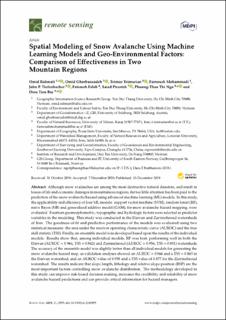| dc.description.abstract | Although snow avalanches are among the most destructive natural disasters, and result in losses of life and economic damages in mountainous regions, far too little attention has been paid to the prediction of the snow avalanche hazard using advanced machine learning (ML) models. In this study, the applicability and efficiency of four ML models: support vector machine (SVM), random forest (RF), naïve Bayes (NB) and generalized additive model (GAM), for snow avalanche hazard mapping, were evaluated. Fourteen geomorphometric, topographic and hydrologic factors were selected as predictor variables in the modeling. This study was conducted in the Darvan and Zarrinehroud watersheds of Iran. The goodness-of-fit and predictive performance of the models was evaluated using two statistical measures: the area under the receiver operating characteristic curve (AUROC) and the true skill statistic (TSS). Finally, an ensemble model was developed based upon the results of the individual models. Results show that, among individual models, RF was best, performing well in both the Darvan (AUROC = 0.964, TSS = 0.862) and Zarrinehroud (AUROC = 0.956, TSS = 0.881) watersheds. The accuracy of the ensemble model was slightly better than all individual models for generating the snow avalanche hazard map, as validation analyses showed an AUROC = 0.966 and a TSS = 0.865 in the Darvan watershed, and an AUROC value of 0.958 and a TSS value of 0.877 for the Zarrinehroud watershed. The results indicate that slope length, lithology and relative slope position (RSP) are the most important factors controlling snow avalanche distribution. The methodology developed in this study can improve risk-based decision making, increases the credibility and reliability of snow avalanche hazard predictions and can provide critical information for hazard managers | en_US |

